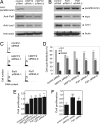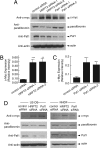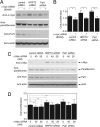The parafibromin tumor suppressor protein inhibits cell proliferation by repression of the c-myc proto-oncogene
- PMID: 18987311
- PMCID: PMC2582266
- DOI: 10.1073/pnas.0710725105
The parafibromin tumor suppressor protein inhibits cell proliferation by repression of the c-myc proto-oncogene
Abstract
Parafibromin is a tumor suppressor protein encoded by HRPT2, a gene recently implicated in the hereditary hyperparathyroidism-jaw tumor syndrome, parathyroid cancer, and a subset of kindreds with familial isolated hyperparathyroidism. Human parafibromin binds to RNA polymerase II as part of a PAF1 transcriptional regulatory complex. The physiologic targets of parafibromin and the mechanism by which its loss of function can lead to neoplastic transformation are poorly understood. We show here that RNA interference with the expression of parafibromin or Paf1 stimulates cell proliferation and increases levels of the c-myc proto-oncogene product, a DNA-binding protein and established regulator of cell growth. This effect results from both c-myc protein stabilization and activation of the c-myc promoter, without alleviation of the c-myc transcriptional pause. Chromatin immunoprecipitation demonstrates the occupancy of the c-myc promoter by parafibromin and other PAF1 complex subunits in native cells. Knockdown of c-myc blocks the proliferative effect of RNA interference with parafibromin or Paf1 expression. These experiments provide a previously uncharacterized mechanism for the anti-proliferative action of the parafibromin tumor suppressor protein resulting from PAF1 complex-mediated inhibition of the c-myc proto-oncogene.
Conflict of interest statement
The authors declare no conflict of interest.
Figures




References
-
- Carpten JD, et al. HRPT2, encoding parafibromin, is mutated in hyperparathyroidism-jaw tumor syndrome. Nat Genet. 2002;32:676–680. - PubMed
-
- Jackson CE, et al. Hereditary hyperparathyroidism and multiple ossifying jaw fibromas: A clinically and genetically distinct syndrome. Surgery. 1990;108:1006–1012. - PubMed
-
- Chen JD, et al. Hyperparathyroidism-jaw tumour syndrome. J Intern Med. 2003;253:634–642. - PubMed
-
- Simonds WF, et al. Familial isolated hyperparathyroidism is rarely caused by germline mutation in HRPT2, the gene for the hyperparathyroidism-jaw tumor syndrome. J Clin Endocrinol Metab. 2004;89:96–102. - PubMed
-
- Shattuck TM, et al. Somatic and germ-line mutations of the HRPT2 gene in sporadic parathyroid carcinoma. N Engl J Med. 2003;349:1722–1729. - PubMed
Publication types
MeSH terms
Substances
Grants and funding
LinkOut - more resources
Full Text Sources
Other Literature Sources
Molecular Biology Databases

